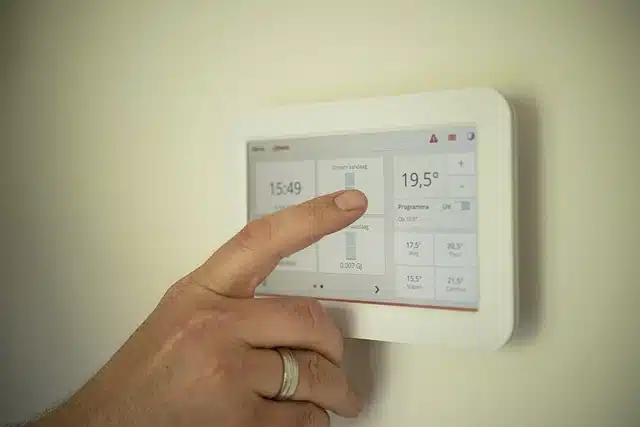Exploring the vast realm of alternative energy sources for home heating and cooling isn’t just an exercise in eco-friendly living. In today’s world, it’s a necessity. This comprehensive guide seeks to aid that exploration, shedding light on established and emergent technologies that could revolutionize how we heat and cool our homes.
Let’s delve into the nitty-gritty of one such technology – geothermal heat pump installation. This energy solution has proven to be a game-changer in sustainable home comfort solutions.
Harnessing The Earth’s Heat: Geothermal Heat Pump Installation
Harnessing the earth’s natural warmth, geothermal heat pumps work by absorbing heat from the ground and using it to warm your home. When it’s hot outside, the process reverses, providing a cool, comfortable indoor environment. Though the initial investment can be substantial, you’ll enjoy significant energy savings in the long run.
Understanding The Power of The Sun: Solar Heating
The advent of modern solar panels has revolutionized the world of home heating and cooling. These panels, which have become increasingly efficient and affordable, allow homeowners to harness the sun’s power and convert it into electricity for heating and cooling purposes. By utilizing solar heating, homeowners can significantly reduce their dependence on traditional energy sources, such as gas or electricity.
Energy providers such as Fairway Energy are at the forefront of this revolution, offering grant-funded energy-saving solutions, including solar. They provide comprehensive services, from initial consultation and system design to installation and maintenance. With government incentives and financing options available, making the switch to solar heating has never been more accessible.
Solar heating systems are designed to capture the sun’s energy through photovoltaic cells, which convert sunlight into usable electricity. This electricity can power heating and cooling systems, providing a sustainable and environmentally friendly solution.
By embracing solar heating, homeowners reduce their carbon footprint and enjoy the benefits of lower energy bills and increased energy independence. As technology continues to advance and solar panels become even more efficient, the impact of solar heating on the world of home heating and cooling is expected to grow, making it a compelling option for homeowners seeking alternative energy sources.
Harnessing The Breeze: Residential Wind Turbines
Residential wind turbines present a unique and innovative approach to home energy solutions. By capturing the power of the wind, these turbines convert wind energy into electricity that can be used to meet a home’s heating and cooling needs. While the effectiveness of residential wind turbines depends on location and wind speed, they can be a viable alternative to traditional energy sources in the right conditions.
Installing residential wind turbines requires careful consideration of the surrounding environment, including wind patterns and obstructions.
A professional assessment is essential to determine if the location is suitable for harnessing wind energy and to ensure the proper installation and functionality of the turbines. When employed in areas with consistent and strong winds, residential wind turbines can significantly reduce reliance on traditional energy sources and provide homeowners with a sustainable and cost-effective solution for home heating and cooling.
Going With the Flow: Hydroelectric Systems
Small-scale hydroelectric systems provide another alternative energy source for powering home heating and cooling systems. Hydroelectric power offers a compelling option if your property has access to a stream or river. These systems harness the natural flow of water and convert it into electricity that can be used to power your home’s heating and cooling needs.
To install a small-scale hydroelectric system, a professional must assess the flow rate, head, or vertical distance between the water source and turbine. The turbine, which is connected to a generator, converts the mechanical energy of the flowing water into electricity.
Regular maintenance is necessary to ensure the proper functioning of the hydroelectric system. While small-scale hydroelectric systems require specific locations to work effectively, they can provide a reliable and sustainable alternative to traditional energy sources for powering home heating and cooling systems.
Burning Bright: Bioenergy Heating Systems
Bioenergy heating systems are truly unique. Using organic materials, such as wood pellets or crop residues, they tap into a renewable resource that’s often abundant. The heat generated from these organic materials can be harnessed to warm your home, presenting a cost-effective and sustainable solution.
Furthermore, these systems offer an innovative approach to waste management. Surprisingly, even everyday garbage can be converted into a viable heating source. This feature not only aids in reducing landfill waste but also turns a problem into a solution.
The Magic of Magnets: Magnetic Air Conditioners
Magnetic air conditioners mark a breakthrough in cooling technology. Employing the power of magnets, they generate a cooling effect that’s both effective and innovative. This technology doesn’t rely on refrigerants, sidestepping the environmental harm associated with traditional cooling methods.
Additionally, these systems pose a promising alternative to conventional air conditioning. By eschewing refrigerants, magnetic air conditioners demonstrate the potential for a more sustainable future in home cooling, aligning with global efforts to minimize environmental impacts.
Conclusion
There’s no one-size-fits-all approach to alternative home heating and cooling energy sources. What works for one homeowner might not work for another. Evaluating your home’s unique needs, local environment, and budget is important before deciding on an energy source.
You may be thinking, where does this leave us?
Well, exploring these alternative energy sources not only impacts your wallet and comfort but also benefits the environment. Remember, every step toward more sustainable heating and cooling options for your home is a stride towards a greener, healthier planet.
